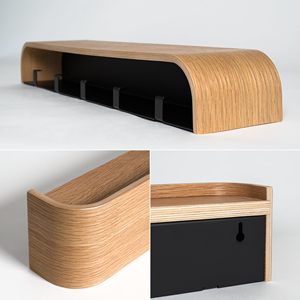
All categories
Featured selections
Trade Assurance
Buyer Central
Help Center
Get the app
Become a supplier

(36392 products available)















































A clothes rail is a simple yet essential item often used in retail stores, workshops, or even homes. It allows users to hang clothes for display, organization, or drying purposes. Clothes rails come in different types, which are as follows:
Freestanding Clothes Rail:
Freestanding clothes rails are popular for home use and can also be found in smaller boutiques. They are not permanently fixed and can be moved from one place to another. They consist of a horizontal rod supported by two vertical posts. Since they are not fixed, they can be easily assembled and disassembled. They can also be made using different materials such as wood, metal, or a combination of both.
Wall-Mounted Clothes Rail:
These clothes rails are for hanging clothes on the wall. They are permanently fixed and cannot be moved. Wall-mounted clothes rails are made of rods and brackets. The rod is where the clothes are hung, and the bracket supports the rod and is fixed to the wall. They are used in places with limited floor space, as they help utilize the wall space.
Telescopic Clothes Rail:
This type of rail is versatile because it can be used both as a freestanding or telescopic clothes rail. It is also known for its ability to adjust in height and width. Therefore, it is suitable for different types of spaces and clothes. It can be used in the home, in a boutique, or even in a laundry area. It is usually made of metal and has a sleek design. It can also be moved around easily because of its lightweight nature.
Heavy-Duty Clothes Rail:
As the name suggests, these clothes rails are strong and can support a lot of weight. They are mainly used in commercial settings like warehouses and retail stores. They are usually made of industrial-grade metal, which is very strong. They also have a larger hanging capacity and often come with additional features such as garment clips and hanging baskets.
Scandinavian Clothes Rail:
Scandinavian clothes rails are known for their simple and elegant design. They are usually made from quality materials, which makes them very stylish. Scandinavian clothes rails can be used in homes for hanging clothes or in boutiques for displaying clothes.
Below are some of the functions of clothing racks:
Clothes rails are used for different purposes in various industries. Wholesale clothes racks are purchased by retailers, fashion designers, organized event planners, storage companies, and homeowners. Each buyer has a different use for the clothing rail. Let’s explore the application of clothes rails in different industries.
Wholesale buyers should consider several factors when choosing clothes rails for resale. They should pay attention to the material, fixed vs. foldable rail, the type of base, and the load capacity.
The material from which a rail is made affects its durability and aesthetic appearance. Buyers should purchase clothes rails made of strong but lightweight materials. Such options are easy to move and transport but also durable. Aluminum and stainless steel are great options for rail material. They are lightweight but strong. When choosing wooden clothes rails, buyers should look for options made of poplar or beechwood.
Fixable clothes rails are more suitable for retail stores. They come in various sizes and can be adjusted to fit the store's specific space requirements. Foldable clothes rails are a better choice for customers with limited storage space. They can be stored away when not in use.
Clothes rails are also available in different base types. For example, clothes rail with wheel base is easy to move around. They are a great choice for organizing clothes in different parts of the house. Non-slip casters protect the floor from damage and make the rail stable when moved. Flat base clothes rails provide a more elegant look. They are suitable for retail stores and showrooms.
All kinds of clothes rails have a load capacity. This is the maximum weight they can support without bending or breaking. When shopping, buyers should look for options with high load capacity. This ensures the rail can hold a lot of clothes. Load capacity is affected by the rail's material, thickness, and length.
Q1: What are the load limits for a clothes rail?
A1: The load limit depends on the rail material, diameter, and support design. Strong metal rails can carry 50-100 kg or more. Testing with weights is advised to determine capacity.
Q2: Is it possible to extend or shorten a clothes rail?
A2: Telescopic or adjustable clothes rails can be extended or shortened. Fixed rails cannot be shortened.
Q3: What is the best way to clean a clothes rail?
A3: Wipe metal clothes rails with a damp cloth and mild detergent. Remove any rust using sandpaper or rust remover. Polish wooden rails and dust regularly.
Q4: Can clothes rails be used outdoors?
A4: Only galvanized steel or treated wooden rails are suitable for outdoor use. They resist weather elements.
Q5: Are clothes rails easy to assemble and disassemble?
A5: Most clothes racks are simple to put together and take apart using hand screws or snap-fit joints. Permanent clothes rails require professional installation and are not meant to be removed.